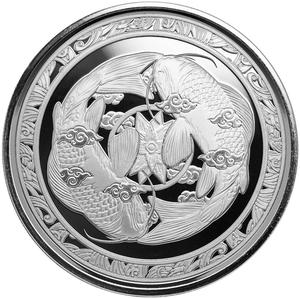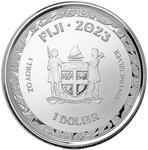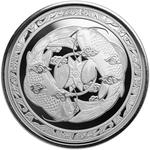The Fijian Dollar has been the currency of Fiji since 1969, when it replaced the pre-decimal Fijian Pound. It is normally abbreviated with the dollar sign $, or alternatively FJ$ to distinguish it from other dollar-denominated currencies.
Apart from the regular circulating coinage, the country has also authorised some foreign mints to issue commemorative and bullion coins under its jurisdiction. These are typically in standard bullion sizes, such as one ounce of silver (abbreviated as 1 oz Ag, where "Ag" comes from the Latin word for silver, Argentum).
This design is the first release in the Fiji Koi Fish Yinyang Coin Program by Scottsdale Mint.
Yinyang describes the two complementary forces - yin and yang - that make up all aspects and phenomena of life. It encompasses the actual process of the universe and all that is in it. Yin and yang are depicted as the light and dark halves of a circle.
The mint says about the design:
In the tranquil ponds and water gardens of East Asia, a vibrant and graceful fish glides through the shimmering waters - the koi fish. Revered for centuries, these captivating creatures have captivated both admirers of aquatic beauty and followers of philosophical wisdom. The koi fish, with its radiant scales in a myriad of colors, symbolizes serenity, perseverance, and good fortune.
Originating from ancient China, the koi fish has become an iconic figure in Japanese culture, where it represents strength, courage, and the ability to overcome adversity. With their elegant movements and eye-catching patterns, koi fish gracefully embody the harmonious balance of nature and hold a special place in the hearts of those who appreciate their mesmerizing presence.
The relationship between koi fish and the concept of yin yang is deeply intertwined. In the philosophy of yin yang, two opposing forces, represented by the contrasting colors of black and white, exist in perfect balance and harmony. The koi fish exemplifies this philosophy, with its contrasting hues and symbolic meanings. The black koi is associated with the yin energy, representing the feminine qualities of tranquility and intuition.
Conversely, the white koi embodies the yang energy, signifying masculinity, strength, and assertiveness. Together, these opposing yet complementary forces merge within the koi fish, creating a visual representation of the interconnectedness and harmony in the natural world. Just as the yin yang symbol illustrates the interplay between light and dark, the koi fish showcases the delicate equilibrium between contrasting elements, inspiring a deeper appreciation for the delicate dance of balance in life and nature. | 






 Buy this online from eBay
Buy this online from eBay
 Search for Fiji: Silver Ounce 2023 Koi Fish on eBay
Search for Fiji: Silver Ounce 2023 Koi Fish on eBay 